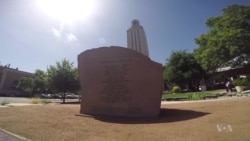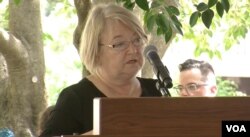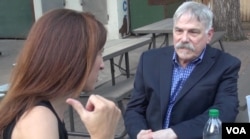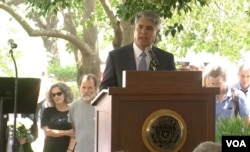It was hot in Austin Monday and the sky was blue, just as it had been on that Monday 50 years ago when people started dropping to the ground. On August 1, 1966, it took people a while to realize that someone was shooting at them from 70 meters up, on the observation deck of the tower that was the emblematic structure on their campus.
The first mass shooting at an American school
Mass shootings have become a sad feature of life in the United States, but 50 years ago there had been very few inexplicable shootings of this sort and none had taken place on a college campus. The sniper was a former U.S. Marine and engineering student named Charles Whitman. What drove him to do it remains a mystery, as is the case with many of the more recent mass shootings in the United States.
The ceremony to commemorate the event began at the same time that the shooting started 50 years ago, at 11:48 am. For the first time since it was constructed in 1936, the tower clock was stopped. In a small garden near the northwest side of the tower there is now a red granite memorial containing the names of 17 people who died either that day in 1966 or later from their wounds.
One of the first people wounded was Claire Wilson, who was pregnant at the time. After she fell, the sniper shot and killed her boyfriend Tom Eckman. She lay there in the hot sun for 90 minutes unable to move, with his body beside her. A red-headed woman named Rita Starpattern came to lay nearby so that she could talk with the wounded woman and keep her awake. Others nearby were afraid to venture out for fear of being shot.
Finally, a 17-year-old student named John Fox rushed out with a friend, grabbed Wilson and carried her to a shielded area where she was placed in an ambulance. She recovered, but lost her baby, now listed on the memorial as “Baby Wilson.”
Fox, who is now a well-known Austin comic actor who goes by the name Artly Snuff, said it has troubled him for a long time that he didn’t go to her sooner. He said he felt like a coward for leaving a pregnant woman bleeding in the hot sun for close to 90 minutes before acting. But, he said, there was no counseling for people like him back then.
“Like at Newtown or Aurora or Orlando, you get a flood of grief counselors that come in after the event and they know that people should talk about it, but back then in ’66, nothing like that happened,” he said.
Claire Wilson’s call for healing
Claire Wilson James, as she is called today, spent weeks in an Austin hospital where she was visited once by Rita Starpattern, the redheaded stranger who had comforted her on the pavement that day. But after leaving the hospital she moved away from Austin and lost contact with people she had known.
Speaking at the memorial ceremony, she called on everyone to “treasure the ones we walk with each moment.”
“Let this memorial remain here on this campus and in our minds as a reminder of the power we have each moment to become a community of love,” she said.
The brave men who killed the sniper and ended the carnage
Another difference between today and five decades ago is that police now have automatic rifles in their vehicles, radios on their belts, bullet-proof vests and other technology that would have only been seen in Science Fiction novels in the 1960s. The police officers who arrived on the scene had only pistols, which were ineffective at long range. One of them, Officer Billy Paul Speed was killed by the sniper while trying to take cover.
Officer Ramiro Ray Martinez ran in a zig-zag pattern to the main building and went up the elevator. On the floor just below the observation deck he met another officer, Jerry Day, and a civilian named Allen Crum. They made their way up to the observation deck and were then joined by Officer Houston McCoy, who carried a shotgun.
Martinez said he went around the northeast corner of the deck and saw Whitman at the far end with an M-1 semiautomatic rifle. He began shooting with his .38 caliber service revolver and was soon joined by McCoy who fired two blasts from his shotgun.
Speaking to VOA, Martinez said, “My gun was empty, so I reached back, grabbed the shotgun and fired one more round into the sniper because he still had the M-1 carbine in his hand and there was motion and I wanted to make sure that he wasn’t going to shoot me.”
Martinez regrets that police supervisors were so ineffective in setting up a plan of action, leaving the incident to go on for more than 90 minutes, while the general scene on campus grew dangerously chaotic.
Civilian riflemen fired from all sides
Gun rights advocates correctly note that civilians with rifles played a role in keeping the sniper pinned down, but after he was dead, the continuing fire from below put Martinez and the other officers at risk. They waved a white cloth to let people know it was over, but the message did not get through until Martinez went down and told people below.
Martinez said the civilians, many of them students with deer hunting rifles, did prevent the sniper from taking careful aim and probably saved lives, but he said it was unorganized and the potential for someone dying from so-called “friendly fire” was ever present.
Focus on heroism and healing
Whether by coincidence or design, Monday was also the day chosen by the Texas legislature to implement the part of the open carry law that applies to state college and university campuses. Martinez said he opposed the Texas law, which allows open carry of handguns on campus. It is an idea opposed by most students and faculty members at the university as well.
But both sides of the gun debate left politics aside for the memorial dedication and in his remarks, University of Texas at Austin President Gregory Fenves emphasized the heroism rather than the violence of that day.
“By focusing on the good, on the stories of the heroes and the lives of the survivors who are here with us this afternoon we can finally begin to remember and endure our burden of the past,” he said.
For decades the university had avoided making an issue of the anniversary, wanting to sweep it into a corner so that the horror of what happened would not stain the school’s reputation. But that meant there was also no memorial for the dead and no recognition of the courage and sacrifice that were also part of that dark chapter in the school’s history.
Fenves said that Monday’s ceremony was “long overdue.” But, at the 50-year mark, it was also a closing of the chapter, for each year fewer and fewer people will be available who were there and remember vividly what happened.
The tower remains a symbol of education and progress that can be seen from parts of Austin many kilometers away from the UT campus. Both those who survived the shooting and those who work and study at the university today prefer that the tower be appreciated for its grandeur and not for its brief association with a madman’s murderous rampage a half a century ago.











